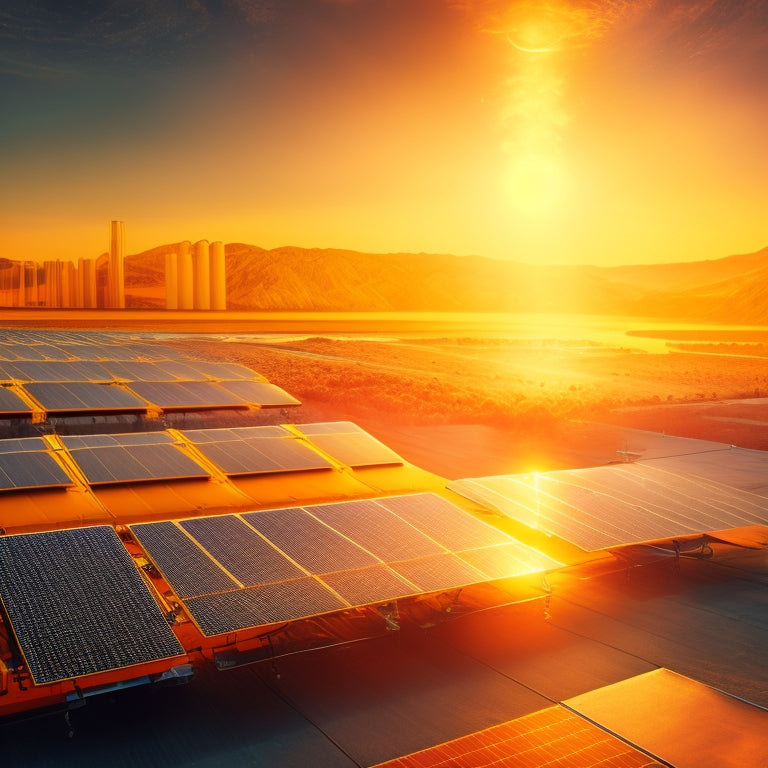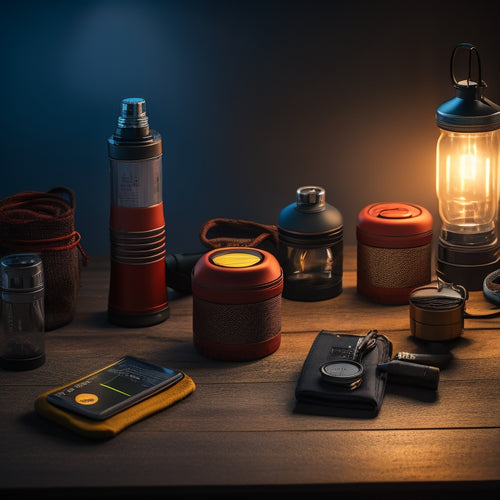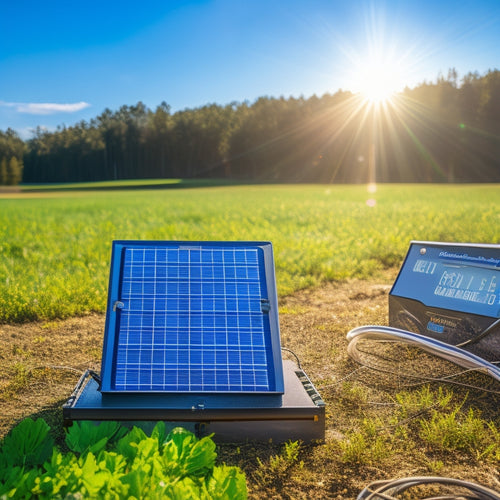
Optimizing Panel Efficiency in High Temperatures
Share
As you operate solar panels in high-temperature environments, you face significant efficiency losses, with up to 0.7-1.0% drops in energy output for every degree Celsius above 50°C. This heat-induced degradation occurs due to thermal energy loss, reduced bandgap energy, and increased thermal resistance. To mitigate these effects, you can utilize thermal management solutions, such as improving insulation, using reflective coatings, and implementing active or passive cooling techniques. By optimizing panel design, orientation, and inverter performance, you can minimize temperature-related losses. Now, find out how to tailor your approach to local climate conditions and access the full potential of your solar panel system.
Overview
- Understanding temperature coefficients helps select suitable panel materials and layouts to maximize energy output in high-temperature environments.
- Improving insulation and thermal conductivity can mitigate thermal energy loss, while active cooling systems and reflective coatings dissipate excess heat.
- Regular evaluation of performance metrics, such as peak power output and open-circuit voltage, reveals areas for improvement in high-temperature conditions.
- Optimizing panel angle and orientation maximizes sunlight exposure on photovoltaic cells, enhancing energy output in high-temperature regions.
- Integrating cooling technologies, such as airflow management and heat sinks, is essential for maintaining peak performance and optimizing energy output in high temperatures.
Understanding Temperature Coefficients
When you're working with solar panels, temperature coefficients are a critical factor to grasp, as they greatly impact the panel's performance. You need to understand how temperature effects alter the coefficient values, affecting the panel's overall efficiency.
Thermal conductivity of panel materials plays a significant role in this process. To enhance performance metrics, you must consider environmental factors like ambient temperature, humidity, and wind speed, which can reduce energy output by up to 50% in extreme conditions high humidity and salt mist.
Panels are designed to withstand gusts and turbulence beyond natural environment levels, with wind speed categories ranging from 100 km/h to 300 km/h. By analyzing these factors, you can tailor your solar energy system to maximize efficiency.
Effective temperature coefficient analysis enables you to select the most suitable panel materials and design an ideal system layout. This, in turn, guarantees you're getting the most out of your solar energy investment, revealing the full potential of your system.
Heat's Impact on Solar Panels
You're likely aware that high temperatures can greatly impact your solar panel's performance. As temperatures rise, you'll experience thermal energy loss, which reduces your panel's overall efficiency.
The rate at which this degradation occurs is known as the performance degradation rate, which you'll want to understand to optimize your panel's output. Remarkably, advancements in battery technology, such as solid-state breakthroughs, have improved energy storage capabilities, making solar panels more efficient even in high temperatures.
Additionally, economies of scale in production have led to reduced costs, making solar energy more competitive with fossil fuels.
Thermal Energy Loss
As solar panels absorb sunlight, they inevitably heat up, and this temperature increase has a significant impact on their energy output. You need to mitigate thermal energy loss to optimize panel efficiency.
Efficiency losses range from 0.4% to 1.0% per degree Celsius above 25°C temperature coefficients, with losses reaching 0.7-1.0% for each degree above 50°C. High temperatures lead to decreased energy output and reduced overall efficiency, particularly affecting performance in desert regions.
One approach is to improve solar panel insulation, reducing heat gain from the ambient environment. Thermal conductivity improvements in photovoltaic materials can also minimize temperature-related losses.
Active cooling systems can be integrated to dissipate heat, while reflective coatings can reduce energy absorption. Additionally, optimizing heat transfer through advanced thermal management solutions can help.
Performance Degradation Rate
They've spent years perfecting solar panel design, but heat still remains a significant obstacle to ideal performance.
As you assess your solar panel's performance, it's crucial to evaluate the performance degradation rate. This metric measures how efficiently your panels convert sunlight into energy over time, considering the detrimental effects of heat.
You'll want to evaluate your panels' performance metrics, such as peak power output and open-circuit voltage, to determine their efficiency benchmarks.
By doing so, you'll be able to identify areas for improvement and optimize your panel's design to minimize heat-induced degradation.
High Temperature Efficiency Loss
You're likely aware that high temperatures can considerably impact your solar panel's performance.
As temperatures rise, you can expect to see heat-induced power loss, an increase in thermal resistance, and raised temperature decay, all of which can compromise your panel's overall efficiency.
Heat-Induced Power Loss
Prolonged exposure to high temperatures can take a toll on your panel's performance, causing a significant dip in power output. As temperatures rise, your panel's efficiency takes a hit, resulting in heat-induced power loss. This loss can be substantial, reducing your panel's overall energy production.
To mitigate this effect, it's crucial to implement effective thermal management strategies. By optimizing your panel's thermal design, you can minimize heat buildup and reduce power loss. This can be achieved through advanced materials, clever component placement, and smart cooling systems.
Thermal Resistance Increase
As temperatures soar, your panel's internal thermal resistance increases, further exacerbating the heat-induced power loss. This rise in thermal resistance hinders heat dissipation, allowing temperatures to escalate and energy absorption to decrease.
To combat this, you can employ insulation materials with high thermal conductivity to minimize heat buildup. Surface coatings and cooling technologies can also be applied to enhance heat dissipation and regulate temperature.
By implementing these strategies, you can mitigate the impact of thermal resistance on your panel's efficiency. However, it's crucial to remain aware of your panel's efficiency thresholds to guarantee peak performance.
Elevated Temperature Decay
High-temperature conditions trigger a phenomenon known as raised temperature decay, which leads to a significant decline in your panel's efficiency. As temperatures rise, the semiconductor material's bandgap energy decreases, causing a drop in voltage and current output. This results in a substantial loss of power, compromising your panel's overall performance.
| Temperature (°C) | Efficiency Loss (%) | Power Loss (W) |
|---|---|---|
| 50 | 3.5 | 10 |
| 70 | 7.2 | 20 |
| 90 | 12.1 | 35 |
To mitigate this effect, it is crucial to focus on temperature resilience and thermal management. By implementing effective cooling systems and materials with high thermal conductivity, you can minimize the impact of increased temperature decay and guarantee your panel operates at peak levels, even in harsh environments.
Cooling Methods for Solar Panels
Your solar panel's surface temperature significantly impacts its energy conversion efficiency, and excessive heat can lead to a substantial decline in performance.
To mitigate this, you can employ various cooling methods. Passive cooling techniques involve using reflective surfaces, thermal insulation, and ventilation strategies to reduce heat gain.
Active cooling methods, on the other hand, make use of airflow management, heat sinks, and evaporative cooling systems to dissipate heat.
Additionally, solar shading can be implemented to block direct sunlight during peak hours.
By integrating these cooling technologies, you can minimize temperature-related losses and enhance your solar panel's energy output.
Effective cooling methods are essential to maintaining peak panel performance and ensuring your freedom from energy dependence.
Temperature Effects on Inverter
Measure the inverter's operating temperature, and you'll reveal an important factor influencing its performance and reliability. High temperatures can greatly reduce the inverter's efficiency, leading to energy losses and decreased system output.
As the temperature rises, the inverter's components degrade, causing a drop in power conversion efficiency. This can result in reduced energy production and increased maintenance costs.
To mitigate these effects, it's vital to implement efficient cooling systems and optimize inverter technology for high-temperature environments. By doing so, you can guarantee maximum energy output and extend the lifespan of your inverter.
Efficiency optimization is key to discovering the full potential of your solar panel system, even in scorching temperatures.
Panel Angle and Orientation Matter
Ideal panel angle and orientation are crucial for maximizing energy production, as they directly impact the amount of sunlight that reaches the photovoltaic cells.
When you adjust panel alignment, you guarantee that the sun's rays hit the cells at the best angle, resulting in enhanced energy output.
In regions with varying solar irradiance, modifying the panel's orientation can greatly elevate energy production.
By achieving the best positioning, you can reduce energy losses and increase your system's overall efficiency.
As you design your solar panel setup, consider the local climate, time of day, and seasonal changes to determine the ideal panel angle and orientation for your specific installation.
Mitigating Heat With Smart Design
High-temperature operating conditions can considerably impede solar panel performance, leading to reduced energy output and lifespan. You can mitigate this effect by applying smart design principles to your solar panel installation. One approach is to employ passive cooling methods, such as raising the panels to allow for airflow underneath or using heat sinks to dissipate excess heat. Additionally, applying reflective coatings to the panel's backsheet can help reduce heat absorption.
| Design Feature | Heat Reduction Benefit |
|---|---|
| Raised Panel Mount | 10-15% reduction in operating temperature |
| Heat Sink Integration | 5-10% reduction in operating temperature |
| Reflective Backsheet Coating | 3-5% reduction in operating temperature |
| Ventilated Panel Frames | 5-10% reduction in operating temperature |
| Radiative Cooling Surfaces | 10-15% reduction in operating temperature |
Frequently Asked Questions
Can High Temperatures Affect the Lifespan of Solar Panels?
You're right to wonder: high temperatures can indeed affect the lifespan of solar panels, as thermal stress accelerates solar degradation, making thermal management essential to minimize energy losses and guarantee peak performance over time.
Do Solar Panels Perform Better in Cold Climates?
You'll find that solar panels surprisingly thrive in cold climates, as lower temperatures increase their energy output, enhancing solar panel performance and cold climate efficiency, allowing you to utilize more power from the sun's rays.
How Often Should I Clean My Solar Panels to Maintain Efficiency?
You should clean your solar panels every 6-12 months, depending on local pollution and tree debris, to maintain efficiency; regular solar panel maintenance and ideal cleaning frequency guarantee you're generating maximum power and enjoying energy freedom.
Can I Use a Reflective Surface to Cool My Solar Panels?
You can experiment with reflective coatings or strategically place a reflective surface near your panels to cool them, but be cautious of unintended consequences, like increased albedo or reduced irradiance, and carefully analyze the trade-offs before implementation.
Are There Any Temperature-Resistant Solar Panel Materials Available?
You're not alone in seeking a solution that defies the heat - ironically, it's where innovation thrives. You'll find temperature-resilient solar panels made from advanced materials like silicon carbide and gallium nitride, boasting extraordinary material advancements in high-temperature endurance, giving you the freedom to utilize energy unfettered.
Ready to Buy
As you're now well aware, high temperatures can be a solar panel's worst enemy, quietly siphoning away efficiency when you need it most. Ironically, the sun's intense heat, which is supposed to be your greatest asset, can become your biggest liability. But fear not, with a solid understanding of temperature coefficients, cooling methods, and smart design, you can outsmart the heat and keep your panels performing at their best, even when the mercury rises.
Related Posts
-

Solar Phone Chargers for Camping Essentials
Solar phone chargers are must-haves for your camping essentials, allowing you to stay connected while enjoying nature...
-

Best Solar Powered Flashlights for Emergency Situations
When you're choosing the best solar-powered flashlights for emergency situations, focus on their brightness, battery ...
-

Choosing the Right Solar Power Charge Controller
Choosing the right solar power charge controller is crucial for maximizing energy efficiency and extending battery li...


